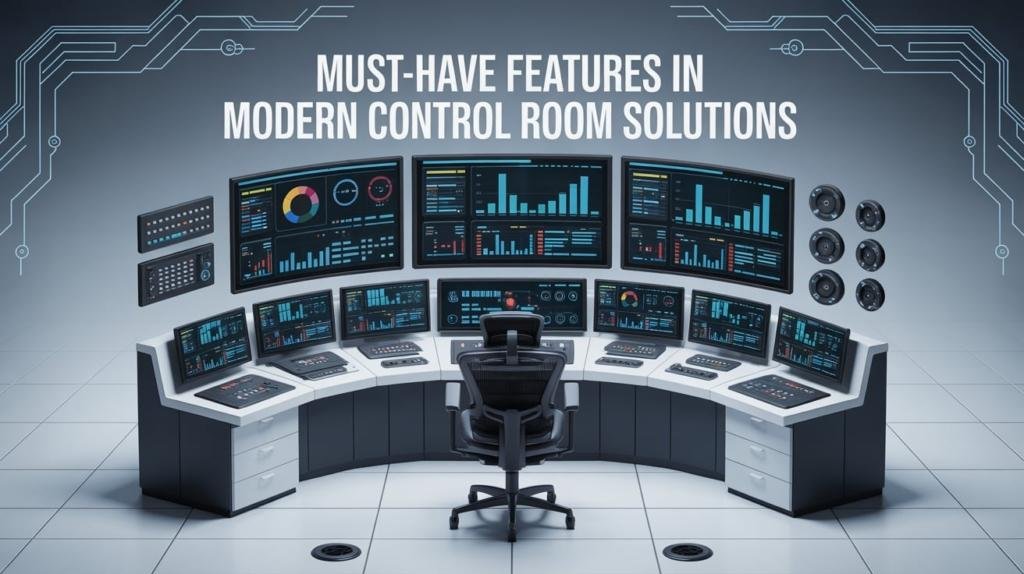Modern control room solutions are evolved command centers that prioritize efficiency, ergonomics, and technology to facilitate the smooth operation of complex systems. Designed with the operator in mind, they provide pleasant and practical work areas with streamlined interfaces, quicker access, and easier task switching.
Table of Contents
To maximize operational efficiency, security, and responsiveness, it is essential to determine which control room components to emphasize while designing or upgrading the space. Here are five must-have features in today’s modern control room solutions:

Real-Time Data Integration and Visualization
A contemporary control room’s beating heart is its ability to collect, analyze, and display massive volumes of data in real time. Operators need fast, well-informed decisions, so the data they are given needs to be concise, dynamic, and easy to understand. This feature’s improved situational awareness and faster anomaly identification will result in fewer operational disruptions.
Modern control room solutions should provide:
- The capacity to incorporate information from several sources, such as sensors, CCTV cameras, software, Internet of Things devices, etc.
- Basic dashboards allow quick access to and action upon complex data.
- Customizable displays with HD resolution video walls with multi-source viewing.
Redundancy and System Resilience
Control room downtime can have critical consequences, such as blackouts, security breaches, or traffic bottlenecks. Thus, modern control room designs have to be strong and redundant.
Protocols for disaster recovery help ensure that, should an emergency strike, operations can quickly resume. Mission-critical operations have to keep running in robust control rooms regardless of anything else going on.
Essential components consist of
Systems are made to ensure that, should a hardware or software crash, operations remain flawless.
Generators and UPS are among the backup power sources one should have.
Real-time mirroring and off-site backups help to create safe data storage.
MFA, or Multi-Factor Authentication
Modern access control systems must include multi-factor authentication (MFA) if we are to ensure that only authorized users may access limited areas. Only MFA—which calls for two-factor authentication—can grant access to protected areas.
PINs, keycards, and facial recognition systems are among the possible user-knowable, user-possessable, or user-behavior-based authentication systems. By combining many validation techniques, Master Factor Authentication (MFA) offers still another protection against unwanted access.
Key Features:
- MFA as a primary access control feature can avoid single-factor authentication breaches like stolen keycards or leaked passwords.
- Modern access control systems make it tougher for intruders to get access without being discovered by requiring numerous credentials.
- MFA can also be customized to require greater authentication for sensitive data or assets, matching access with security.
Ergonomic and Operator-Centric Design
In control room operations, humans still play a key role. Operators want a space that allows them to concentrate, feel well, and get the job done because they frequently work long hours. Also, operators should be able to handle jobs without being overwhelmed by information or distracted by unnecessary screens, therefore, user interfaces should be simple and easy on the brain.
Modern Control Room Solutions and Responsibilities:
- Examples of ergonomically good furniture are workstations with adjustable heights, cozy chairs, and orderly consoles that fit the body.
- Lighting and acoustics were adjusted to minimize the effects on the eyes and reduce the tiredness that noise can induce.
- Maintaining comfort and peace for oneself under environmental control for temperature and air quality.
Lighting: Enhancing Comfort and Concentration
Enough lighting guarantees the maintenance of operator alertness, the decrease of eye strain, and the improvement of a good working environment. Modern control room design benefits from flexible lighting systems able to satisfy different times of the day and duties. This affects production as well as comfort.
Key considerations include:
- Divide the lighting into several zones—e.g., workstations, video walls, paths—to lower glare on screens and provide operators more control.
- Let the user adjust the light’s brightness depending on their need, the time of day, or the type of current job they are doing.
- Separate dimmable switches should be used for direct lighting to highlight concentrated work areas and indirect lighting to provide a general mood.
- Keeping the overhead lights away from display walls and monitors will help reduce eyestrain from constant screen viewing throughout the day.
- Install lighting systems whose color and brightness vary in reaction to the natural light entering the area to create a harmonic ambiance.
Conclusion
Modern control room solutions are strategic assets that support safety, efficiency, and informed decision-making in very crucial settings, not only high-tech rooms with displays.
Regardless of your responsibility for the traffic network, energy grid, or emergency services, the right control room features can significantly enhance operational skills.






Leave a Comment